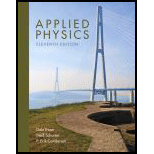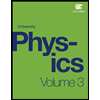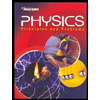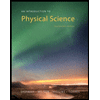
Applied Physics (11th Edition)
11th Edition
ISBN: 9780134159386
Author: Dale Ewen, Neill Schurter, Erik Gundersen
Publisher: PEARSON
expand_more
expand_more
format_list_bulleted
Textbook Question
Chapter 20.5, Problem 15P
If an observer triples her distance from a light source: (a) Does the illumination at that point increase or decrease? (b) In what proportion does the illumination increase or decrease?
Expert Solution & Answer
Want to see the full answer?
Check out a sample textbook solution
Students have asked these similar questions
A ray of light undergoes refraction and looses 0.25 times of its velocity.If ‘i’ is the angle of incidence and is very small,the angle of deviation for the ray of light is______?
When your eye is submerged in water, does the speed of light increase, decrease, or remain constant as it passes from the water into your cornea?
At night, a person (in air) stands, at the edge of a water-filled swimming pool with a flashlight in hand, looking down at an angle into the pool for a set of car keys (he/she) dropped accidentally to the bottom of the pool earlier in the day. The flashlight is adjusted until the keys can be seen. The vertical distance from the flashlight to the water is 1.5m. The horizontal distance from the flashlight to the point at which the light beam enters the water is 1.7m. The pool is 5m deep. What is the horizontal distance, measured from the from the edge of the pool, starting at the bottom, to the keys? Consider the index of refraction for both air and water in your calculations.
Chapter 20 Solutions
Applied Physics (11th Edition)
Ch. 20.2 - Find the distance (in metres) traveled by a radio...Ch. 20.2 - Prob. 2PCh. 20.2 - A television signal is sent to a communications...Ch. 20.2 - How long does it take for a radio signal from the...Ch. 20.2 - The sun is 9.30107mi from the earth. How long does...Ch. 20.2 - A radar wave is bounced off an airplane and...Ch. 20.2 - How long does it take for a radio wave to travel...Ch. 20.2 - How long does it take for a flash of light to...Ch. 20.2 - How long does it take for a police radar beam to...Ch. 20.2 - How far away (in km) is an airplane if the radar...
Ch. 20.2 - An auto mechanic uses a strobe light to time a...Ch. 20.2 - A construction company uses GPS technology to...Ch. 20.2 - (a) How long does it take for light to reach the...Ch. 20.2 - Prob. 14PCh. 20.2 - How long does it take light to reach the earth...Ch. 20.2 - Preparing for reentry, astronauts use radar to...Ch. 20.2 - Prob. 17PCh. 20.2 - Light from the sun travels 1.50108 km to reach the...Ch. 20.3 - c=3.00108m/s =4.55105m f=?Ch. 20.3 - c=3.00108m/s =9.701010m f=?Ch. 20.3 - c=3.00108m/s f=9.701011Hz =?Ch. 20.3 - c=3.00108m/s f=24.2 MHz =?Ch. 20.3 - c=3.00108m/s f=45.6 MHz =?Ch. 20.3 - Prob. 6PCh. 20.3 - Prob. 7PCh. 20.3 - Prob. 8PCh. 20.3 - Find the wavelength of a radio wave from an AM...Ch. 20.3 - Find the wavelength of a radio wave from an FM...Ch. 20.3 - Find the frequency of an electromagnetic wave if...Ch. 20.3 - Find the frequency of an electromagnetic wave if...Ch. 20.3 - Prob. 13PCh. 20.3 - Prob. 14PCh. 20.3 - Prob. 15PCh. 20.3 - An AM radio station broadcasts a signal with a...Ch. 20.4 - Prob. 1PCh. 20.4 - Prob. 2PCh. 20.4 - Prob. 3PCh. 20.4 - Find the frequency of electromagnetic radiation...Ch. 20.4 - Find the frequency of electromagnetic radiation...Ch. 20.4 - Prob. 6PCh. 20.4 - Find the frequency of electromagnetic radiation...Ch. 20.4 - Prob. 8PCh. 20.4 - Prob. 9PCh. 20.4 - Prob. 10PCh. 20.4 - Prob. 11PCh. 20.4 - Prob. 12PCh. 20.4 - An AM radio station in a nearby town broadcasts a...Ch. 20.5 - I=48.0 cd I=___mCh. 20.5 - Prob. 2PCh. 20.5 - I=765 m I=___ cdCh. 20.5 - I=432 m I=___ cdCh. 20.5 - I=75.0 cd I=___ mCh. 20.5 - I=650 m I=___ cdCh. 20.5 - I=900 m r=7.00 ft E=?Ch. 20.5 - I=741 m r=6.50 m E=?Ch. 20.5 - I=893 m r=3.25 ft E=?Ch. 20.5 - E=4.32 lux r=9.00 m I=?Ch. 20.5 - E=10.5 ft-candles r=6.00 ft I=?Ch. 20.5 - Prob. 12PCh. 20.5 - Prob. 13PCh. 20.5 - Prob. 14PCh. 20.5 - If an observer triples her distance from a light...Ch. 20.5 - If the illuminated surface is slanted at an angle...Ch. 20.5 - Find the illumination on a surface by three light...Ch. 20.5 - Find the intensity of two identical light sources...Ch. 20.5 - Find the intensity of two identical light sources...Ch. 20.5 - A desk is 3.35 m below an 1850-m incandescent...Ch. 20 - Which of the following are examples of...Ch. 20 - Prob. 2RQCh. 20 - Prob. 3RQCh. 20 - Light behaves a. as a massive particle. b. always...Ch. 20 - Does the wavelength of light depend on its...Ch. 20 - Prob. 6RQCh. 20 - How does the intensity of illumination depend on...Ch. 20 - In your own words, explain how the speed of light...Ch. 20 - Does light always travel at the same speed?...Ch. 20 - What name is given to the entire range of waves...Ch. 20 - Prob. 11RQCh. 20 - Who developed the wave packet theory of light?Ch. 20 - Who made the first estimate of the speed of light?Ch. 20 - How was the first estimate of the speed of light...Ch. 20 - What are the units of luminous intensity?Ch. 20 - In your own words, explain luminous intensity.Ch. 20 - Find the distance (in metres) traveled by a radio...Ch. 20 - A radar wave that is bounced off an airplane...Ch. 20 - How long does it take for a police radar beam to...Ch. 20 - Prob. 4RPCh. 20 - How long does it take for a radio signal to travel...Ch. 20 - Find the wavelength of a radio wave from an AM...Ch. 20 - Find the frequency of a radio wave if its...Ch. 20 - Prob. 8RPCh. 20 - Prob. 9RPCh. 20 - Prob. 10RPCh. 20 - Prob. 11RPCh. 20 - Prob. 12RPCh. 20 - Prob. 13RPCh. 20 - Find the intensity of the light source necessary...Ch. 20 - Prob. 15RPCh. 20 - Find the intensity of two identical light sources...Ch. 20 - Find the illumination on a surface by three light...Ch. 20 - Prob. 1ACCh. 20 - (a) When the Apollo astronauts landed on the moon,...Ch. 20 - Prob. 3ACCh. 20 - The individual rods on rooftop antennas are...Ch. 20 - Prob. 5AC
Additional Science Textbook Solutions
Find more solutions based on key concepts
Description of Motion:
Tutorials in Introductory Physics
3. What is free-fall, and why does it make you weightless? Briefly describe why astronauts are weightless in th...
The Cosmic Perspective
Suppose you are doing a physics lab that asks you to put a resistor into a circuit, but all the resistors suppl...
University Physics Volume 2
The pV-diagram of the Carnot cycle.
Sears And Zemansky's University Physics With Modern Physics
6. State Newton's second law.
Conceptual Physical Science (6th Edition)
3. What is free-fall, and why does it make you weightless? Briefly describe why astronauts are weightless in th...
The Cosmic Perspective (8th Edition)
Knowledge Booster
Learn more about
Need a deep-dive on the concept behind this application? Look no further. Learn more about this topic, physics and related others by exploring similar questions and additional content below.Similar questions
- What happens to a light wave when it travels from air into glass? (a) Its speed remains the same. (b) Its speed increases. (c) Its wavelength increases. (d) Its wavelength remains the same. (e) Its frequency remains the same.arrow_forwardLight passes from a material with index of refraction 1.3 into one with index of refraction 1.2. Compared with the incident ray, what happens to the refracted ray? (a) It bends toward the normal. (b) It is undeflected. (c) It bends away from the normal.arrow_forwardThe index of refraction for water is about 43. What happens as a beam of light travels from air into water? (a) Its speed increases to 43c, and its frequency decreases. (b) Its speed decreases to 34c, and its wavelength decreases by a factor of 34. (c) Its speed decreases to 34c, and its wavelength increases by a factor of 43. (d) Its speed and frequency remain the same. (e) Its speed decreases to 34c, and its frequency increases.arrow_forward
- For specular reflection, what is the situation with an angle of incidence of (a) 0 and (b) 90?arrow_forwardA light ray initially in water enters a transparent substance at an angle of incidence of 37.0, and the transmitted ray is refracted at an angle of 25.0. Calculate the speed of light in the transparent substance.arrow_forwardWhy is the index of refraction always greater than or equal to 1?arrow_forward
- Suppose a man stands in front of a mm-or as show below. His eyes are 1.65 m above the floor and the top of his head is 0.13 m higher. Find the height above the floor of the top and bottom of the smallest minor in which he can see both the top of his head and his feet. How is this distance related to the man’s height?arrow_forwardCheck Your Understanding in Example 1.6, we had n1n2. If n2were decreased such thatn1n2and the speed of light in medium 2 is faster than in medium 1, what would happen to the length of AA’ ? What would happen to the wave front A’B and the direction of the refracted ray?arrow_forwardIf bis Brewster’s angle for light reflected from the top of an interface between two substances, and bis Brewster’s angle for light reflected from below, prove that b+b=90.0arrow_forward
- Why won’t two small sodium lamps, held close together, produce an interference pattern on a distant screen? What if the sodium lamps were replaced by two laser pointers held close together?arrow_forwardWhat is the speed of light in water? In glycerine?arrow_forwardFor refracted light rays, the angle of refraction: is always equal to the incident angle is always greater than the incident angle is always less than the incident angle is always equal to the critical angle can be less than, greater than, or equal to angle of incidencearrow_forward
arrow_back_ios
arrow_forward_ios
Recommended textbooks for you
 University Physics Volume 3PhysicsISBN:9781938168185Author:William Moebs, Jeff SannyPublisher:OpenStax
University Physics Volume 3PhysicsISBN:9781938168185Author:William Moebs, Jeff SannyPublisher:OpenStax Principles of Physics: A Calculus-Based TextPhysicsISBN:9781133104261Author:Raymond A. Serway, John W. JewettPublisher:Cengage Learning
Principles of Physics: A Calculus-Based TextPhysicsISBN:9781133104261Author:Raymond A. Serway, John W. JewettPublisher:Cengage Learning Glencoe Physics: Principles and Problems, Student...PhysicsISBN:9780078807213Author:Paul W. ZitzewitzPublisher:Glencoe/McGraw-Hill
Glencoe Physics: Principles and Problems, Student...PhysicsISBN:9780078807213Author:Paul W. ZitzewitzPublisher:Glencoe/McGraw-Hill An Introduction to Physical SciencePhysicsISBN:9781305079137Author:James Shipman, Jerry D. Wilson, Charles A. Higgins, Omar TorresPublisher:Cengage Learning
An Introduction to Physical SciencePhysicsISBN:9781305079137Author:James Shipman, Jerry D. Wilson, Charles A. Higgins, Omar TorresPublisher:Cengage Learning

University Physics Volume 3
Physics
ISBN:9781938168185
Author:William Moebs, Jeff Sanny
Publisher:OpenStax

Principles of Physics: A Calculus-Based Text
Physics
ISBN:9781133104261
Author:Raymond A. Serway, John W. Jewett
Publisher:Cengage Learning

Glencoe Physics: Principles and Problems, Student...
Physics
ISBN:9780078807213
Author:Paul W. Zitzewitz
Publisher:Glencoe/McGraw-Hill

An Introduction to Physical Science
Physics
ISBN:9781305079137
Author:James Shipman, Jerry D. Wilson, Charles A. Higgins, Omar Torres
Publisher:Cengage Learning
Polarization of Light: circularly polarized, linearly polarized, unpolarized light.; Author: Physics Videos by Eugene Khutoryansky;https://www.youtube.com/watch?v=8YkfEft4p-w;License: Standard YouTube License, CC-BY